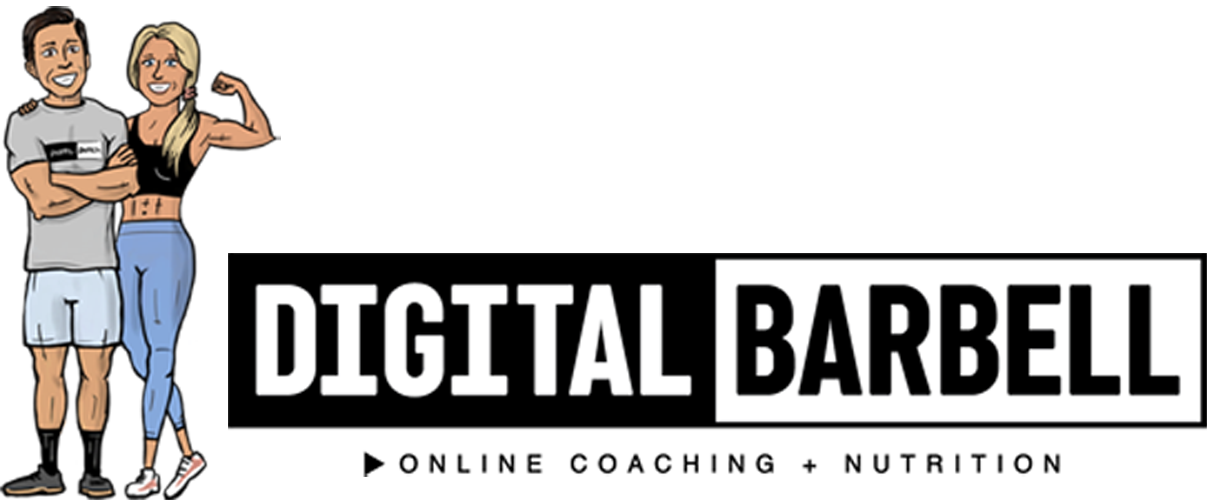How To Maintain Your Metabolism and Avoid Losing Muscle on Weight Loss Drugs
Any time you lose weight, you lose a combination of body fat and lean mass/muscle. It’s simply unavoidable.
During rapid weight loss, you’re at an increased risk of losing muscle, bone density, and seeing a decline in your metabolism. However, there are powerful variables in your control to minimize the loss of muscle, preserve bone density, and slow the decline of your metabolism.
Those variables have to do with what you eat (your nutrition), and what you do with your body (your exercise). After you read through this article and our suggestions, you’ll be armed with what you need to know to be successful long-term. We want you to lose the weight, and keep it off for good.
By the way…We're Jonathan & Blakley Fletcher. Together we own and operate Digital Barbell. An online coaching business dedicated to meeting our clients where they are, and helping them get in the best shape of their lives regardless of age. Blakley has been coaching for over a decade and specializes in workout programs that not only get results but are fun to do. Jonathan heads things up on the nutrition side, providing practical education that cuts through the fads that hold people back from reaching their goals. We're happy to be a part of your journey!
Before we dig in, click the button below and download the “Weight Loss Success Guide” that goes along with this article. All of the nutrition recommendations, and 3 sample workout programs referenced in this article are included in the guide.
What Causes Weight Loss?
Energy balance is the concept that controls whether you gain weight, lose weight, or stay the same.
It’s the relationship between the calories in the food you eat over the course of time and the calories you burn during that same time. Think of energy balance in terms of weekly and monthly averages, not on a day-to-day basis.
It’s important to note the difference between:
Weight Maintenance: If your weight stays about the same over time you are in weight maintenance. The number of calories you are eating is matching up closely to the number of calories you are burning.
Weight Loss: If your weight goes down over time, you are in a calorie deficit. The number of calories you’re eating is fewer than the number of calories you’re burning. Your body makes up for the difference in energy by burning your existing body fat.
Weight Gain: If your weight goes up over time, you are in a calorie surplus. The number of calories you are eating is more than the number of calories you are burning, so the extra calories are stored as reserve energy in your fat cells.
What Is Your Metabolism?
Metabolism is the process your body uses to convert food into energy. Metabolism is also commonly referred to as the number of calories your body burns each day.
Your metabolism is mostly determined by your body weight, how much muscle you have, and how active you are on a daily basis.
Many people assume that once you turn 30 or 40 your metabolism and calorie needs drastically decline, making weight loss impossible. That simply isn’t true. A healthy adult’s metabolism doesn’t start noticeably declining until well into their 60’s.
What are Macronutrients?
All food contains calories, and all of those calories can be divided into 3 categories called “Macronutrients”.
Those 3 Macronutrients are Protein, Carbohydrates, and Fat.
All 3 macronutrients can and should be part of your overall nutrition. Let’s dive into the roles of each.
All packaged foods are required to list the 3 macronutrients on the label.
A Typical Nutrition Label
Note the Protein, Carbs, and Fat Listed In Grams Per Serving
Protein
This one is important. The protein in the food that we eat becomes the building blocks for muscle in our bodies. Protein is vital for muscle growth, maintenance, and recovery. Animal sources of protein are preferred as they are the most bioavailable for use in your body
Each gram of protein contains 4 calories.
Carbohydrates
Almost as important as protein is carbohydrates, because this is our source of energy.
Carbohydrates are converted to glucose (sugar) in our bodies and are then burned for energy. Almost every bodily process requires glucose including brain function. Carbs from nutritious sources are your friend.
Each gram of carbohydrate contains 4 calories.
Some examples of carbohydrate sources are: Greens, Squash/Zucchini, Fruit (apples, blackberries, raspberries, blueberries, grapefruit), Oats, Rice, Potatoes, Beans, Chickpeas, Lentils, Asparagus, Broccoli, Cauliflower.
The reason carbohydrates are demonized when it comes to weight loss and weight gain is because foods like pastries, pizza, crackers, chips, cookies, and fried foods are high in carbs. However, if you look at the nutrition facts on these foods, they are also high in fat, which has even more calories than carbs.
Fat
Dietary fat aids our cells in absorbing vitamins and minerals, helps maintain hormone production, and helps keep our hair, skin and nails healthy.
Fat is not as useful as carbohydrates or protein when it comes to exercise and weight loss.
Since fat is over 2x as calorie-dense as protein and carbs, it’s easy to overeat calories on a high-fat diet
Fat contains 9 calories per gram.
Some examples of fat sources are: Fat contained in meat sources like turkey, ground meat, and fish, Fat contained in Milk, Nuts, Avocado, Nut Butters, Cooking Oils, Butter
Fiber
Fiber is found in carbohydrate sources like greens, beans, berries, oats etc.
Fiber aids in digestion, elimination, and gut health along with a host of other beneficial processes that keep us healthy.
We would be doing you a disservice if we advised you on your nutrition without helping you eat healthy amounts of fiber.
Ladies: Aim for 20-30g per day.
Men: Aim for 30-40g per day.
Some examples of fiber sources are: Beans, Lentils, Split Peas, Green Peas, Figs, Avocado, Raspberries, Blackberries
TIP: Add fiber to your diet slowly.
Our Specific Recommendations For You
Now that we have the basics of nutrition and metabolism covered, let’s arm you with the action steps you need to take on a daily and weekly basis to preserve your muscle and metabolism as you lose weight.
Nutrition Recommendations (What to eat to maintain your muscle and metabolism when losing weight on weight loss drugs)
1: Drink 60-80 fluid ounces of water each day
Start each morning with 12-16 ounces before food or coffee. Every cell in your body needs water to function properly, and hydrating first thing is a great way to start your day.
Expect better digestion, more energy, healthier skin, improved cognition, and better overall results with proper hydration.
We suggest getting an insulated water bottle that you carry with you. If you struggle with waking during the night, give yourself a cutoff from water at around 7 P.M.
If you’re tech-savvy, set a reminder on your phone to drink several times per day.
Adding sugar-free flavoring to your water may help if you struggle to drink enough plain water
2: Have a source of protein at every meal
Protein is the nutrient that will help you preserve strength and muscle as you lose weight.
The simplest way to eat more protein is to include a source at every meal as often as possible.
Simply aim for approximately ~30 grams of protein (ladies) or ~40 grams of protein (men) from the main source of protein in each meal. Remember, the “main source” is one of the things on the recommended protein list above.
Not sure how much protein is in a food? Check out the sample foods in the section above, or simply use Google!
3: Use your hand as a guide to build meals
Our recommendation to have protein at every meal has you well on your way. But what else should be on your plate? We recommend using the size of your hand as a guide to build balanced meals without counting calories.
Here’s are some visuals from Precision Nutrition:
If you need help making your grocery list and meals, download our free Grocery Guide HERE.
4: Eat Mostly Minimally-Processed Food
Regardless of your goals, we recommend eating mostly real, unprocessed, whole foods that come from an animal or from the earth.
This is the way that you can maintain a healthy weight, eat the most food for the least amount of calories and eat the micronutrients that are prevalent in fruits and vegetables.
We recommend aiming to get at least 80% of your food from minimally processed food sources vs. highly processed ones.
Here are some examples of each:
Less processed foods are higher in health-promoting nutrients like vitamins, minerals, protein, and fiber. Research also suggests that limiting processed foods decreases risk of obesity and heart disease.
Instead of trying to completely eliminate processed foods, ween yourself off until you’re only have 1 or 2 per day.
Exercise Recommendations (What to do to maintain your muscle and metabolism when losing weight on weight loss drugs)
Maintaining strength, muscle, function, & independence is a matter of “Use it or lose it”. This is especially true during a period of weight loss. Luckily, the formula for what’s needed to stop muscle loss is not complicated.
1: Walking
If you’re extremely de-conditioned, the best place to start is by walking. How much are you walking now? If you don’t know, find your baseline over the next week by keeping track of how much you walk. Use the following table to log the date, time, and places you walk over the next week.
From your baseline, add 2 minutes of walking per day until you’re walking around 30 minutes every day. You can even break this up into 3 10 minute walks if needed. Bonus points if you walk after a meal.
2: Resistance Training
When it comes to your muscles, all they need to stick around (and grow) is to be:
A) Challenged with resistance training
B) Be fed with protein
When you challenge your muscles with a resistance band, your own body weight, or even a dumbbell, you signal to the muscle that it needs to be preserved.
We’ve included 3 workout routines in the Weight Loss Success Guide that goes along with this article. One is for beginners, one is for people with people experience, and one is more advanced. Be sure to download the guide with the button below, and follow the one that’s most appropriate for you.
The goal of all resistance training is to gradually increase the difficulty.
If you don’t, your body will no longer send the signal to your muscles to stick around.
That means that you need to increase the resistance, increase the weight, and do more reps gradually over time.
Don’t worry about what you can do now, just focus on being consistent around 3 times per week, and gradually doing a little bit more.
If you’d like an experienced guide throughout this process, feel free to reach out with the button below.









